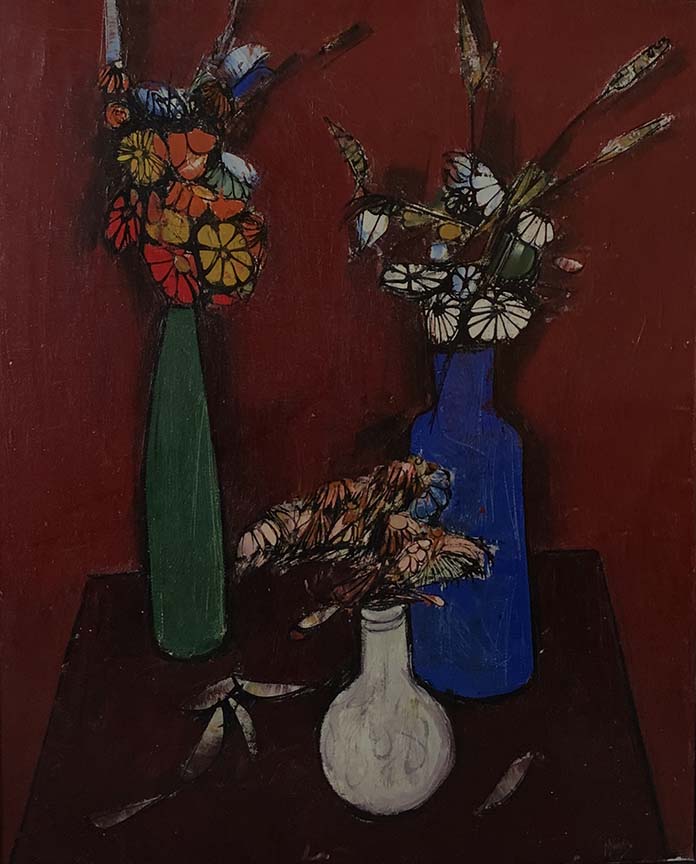

HUBERTUS JOHANNUS MENGELS
"MODERN STILL LIFE"
OIL ON CANVAS, SIGNED
DUTCH, C.1955
33 X 27 INCHES
1921-1995
Translated from Dutch.
Hubertus Johannes (Ber) Mengels, was born in Heerlen, Holland.
He had a number of drawing courses and a course of airplane engineering. He had developed himself not only as a painter but also in many areas, by silencing his all-encompassing curiosity by reading a lot.
His interests were world literature, art history, police, engineering, psychology, and philosophy.In addition, he preferred Wilhelm Reich, Jung, Freud, the centuries-old pessimist. Schopenhauer and Nietzsche, of whom
he knew whole quotes from his head.
He was also interested in the Oriental Zen philosophy.
He also learned a lot from ethnography, partly because of the many travels he had during
The 60's with his wife Pauline made trips to North Africa and
the Balkans.
Those trips also have produced beautiful drawings, watercolors and paintings.
Production and experiment:
Already during the war years, Ber began to draw and paint, but his gigantic production was really continued on after living in The Hague in 1950.
In the early years, the influences of that time in his work are visible in the graphic approach to the subject and in the contour.
By the time he became freer and more selfish.
Protest and resistance continued to be visible and felt in his oeuvre over the years, even in his non-figurative work.
His creativity was governed by two motives: production and experimentation.
Ber worked hard for a lifetime, like a miner. His studio was also one of a kind, it was on a large deep underground, and in which to the layman seemed total chaos prevailed. Stocks of wood, iron, steel and aluminum; old rust machine parts abound, Ber dragged everything from the street, which he thought to be able to use.
That all went up to the ceiling. Manson piles of sheets chart, drawings, sketches, watercolors, paper a cardboard. Shelves full of paintings with homemade charts around it.
Daylight barely barred; Ber always worked with artificial light and usually at night.
"Style is fear" was a body of Ber. It is an expression of resistance to clichés and templates and perhaps also to himself: he did not want to repeat in repetition. Thus, Ber experimented with styles and techniques, from figurative to abstract with oil and acrylic and also with pigment, mixed with glue, resin, wax, dust or sand.
It became beautiful (half) abstract carved landscapes or skies with sometimes crusty layers of paint. If there is ironing light, you will see the intensity of applied paint and structures and the painting comes to life.
Dear Armageddon in the process. Plastics, in the 70's, Ber also began to make images of wood, plastic and paper-Mache and later small statues in bronze. They display the human figure without exception.
Also in these plastics, usually in the body language, there is always something of sarcasm, irony, humor or fool with regard to human destiny.
Around 1990, Ber planed to construct music objects. The music was his hidden love. He loved Schubert, but more of it authentic jazz and folk music, because that's also protest and it's out of the heart of the ordinary man. And of course the Dreigroschenoper. he built dozens of string instruments, sometimes with ethnographic references he made called ironing boards or wall harps. Some possess more than 10 steel strings that you have with real voice mechanics adjust to the correct mutual pitch. Unfortunately, it has never to come to organize a "concert" with professional musicians with some of these string instruments.They are perfectly suited to it and it would undoubtedly be a beautiful symphony of image and sound.
He was highly appreciated as a teacher at, among other things, the Free Academy. Not only because of his great (professional) knowledge, but also because he had his pupils approached democratically. He knew every student and let them to create with great patience and advice ("In the top right, take a little more blue, then you better balance").
Ber was a modest person and had not spent an hour in his life
any promotional activity. He was a member of The Hague's Art Circle since 1954 and was invited in 1969 - by invitation -working member of Pulchri, but he did not belong to any association or artist group. Grouping does equality or at least connectivity supposes, and for this purpose, a single thief was not able to bear.
Meanwhile, he worked steadily and built a very large oeuvre. Ber Mengels has regularly exhibited both in Puchri and beyond.
His work was purchased by the government, municipalities and institutions, and by private collectors who recognized the high quality of their work.